Pharmacology > QUESTIONS and ANSWERS > ATI Pharmacology Study Guide (notes/summary) complete (All)
ATI Pharmacology Study Guide (notes/summary) complete
Document Content and Description Below
ATI Pharmacology Study Guide TIPS: Study the generic names of medications. When in doubt with a food interaction: grape fruit juice is usually the option. Herbal supplements: Many that start with “G... ” increase a patient’s risk of bleeding. Most medications are contraindicated with pregnancy. Not safe to drink alcohol with MOST medications. Patients in general should never stop medications abruptly. In general, if dose is missed do not double up on next dose (birth control exception). DO not chew or crush extended release medications (IMPORTANT). Antibiotics: make sure the patient finishes their course of therapy, get culture before starting antibiotics (IMPORTANT). Chapter One: Pharmacokinetics and Routes of Administration Pharmacokinetics Four Phases of Pharmacokinetics: Absorption: How quickly or how well a medication is absorbed depends on the route. - Oral: more slowly, depends on food in stomach, pH of gastric content. Liquid absorbs more quickly than extended release - Sublingual: Absorbed more quickly, placed under the tongue. Mucosa under tongue is very vascular. Do not eat or drink until medication is completely absorbed. - Inhalation: Absorption happens very quickly. - Intradermal/topical: Absorption is slower. Lidocaine patch: slow steady release. - Subcutaneous/intramuscular: Absorption depends on the solubility of the medication and the blood perfusion at site - IV: absorption happens immediately Distribution: After absorption. Medication travels to the site of action. Medications need binding proteins in order to be distributed to travel to site. Albumin is a common protein used to bind, if pt.’s levels are low, will impact medication distribution. Metabolism: Medication is inactivated or broken down into a less active form by enzymes. Most happens in the liver. Bowel, lungs, and kidneys can also be involved. - Infants have immature metabolism which increases risk for toxicity. Older adults have problems with liver and kidneys which slow down metabolism, leads to higher risk of toxicity - First Pass Effect: Oral medications inactivated through first pass through the liver. May need to give a higher dose for therapeutic effect to be felt - Excretion: Primarily happens in the kidneys. If not working higher risk for toxicity Minimum Effective Concentration and Therapeutic Index: Dosing- want to receive a medication level that is above MEC and but be below level of toxicity. Some medications have a high therapeutic index and some a low therapeutic index (vancomycin). To do this you take blood samples of the medication’s trough levels and peak levels. Medication Half-life: The time the medication is reduced to 50%. Short half-life: eliminated quickly. Long half-life: lingers in body and has increased risk of toxicity. Agonist vs. Antagonist: Agonist: medication designed to produce an action (morphine: bind to receptors and produce an action) Antagonist: medication designed to block an action (naloxone: bind to receptors to block action) Routes of Administration: - Oral: May need to mix with a little apple sauce or pudding to help with swallowing. Patient should sit up right, help with swallowing: tuck chin into chest when swallowing. Should never crush or chew enteric coated or extended release capsules - Sublingual: Under the tongue. Do not eat or drink until completely absorbed - Transdermal: Important to wash the skin with soap and water and dry before putting patch. Remove old patch before putting new one on, rotate sites to prevent irritation. Choose hairless area of skin. - Eye medications: Surgical aseptic technique. Drops: place in the center of the conjunctival sac. After that put gentle pressure on the nasolacrimal duct for 30-60 seconds. Never touch bottle to eye - Ear drops: Place on unaffected sites. Adults: back and up. Children: back and down. - G tube or NG tube: Flush the tube before and after each medication with 15-30mL of sterile water. Flush at the end with the same - Suppositories: Place the patient on left side, place in anus just past the external sphincter and keep it inside of them for at least 5 minutes - Inhalation: Metered dose inhaler: shake at least 5-6 times, breathe out, push inhaler, breathe in 4-5 seconds, then hold breath for 10 seconds before exhaling. Dry powder: Don’t shake, deep breath, hold - IM injections: Under 2 years old use vastus lateralis muscle (IMPORTANT). After that you can also use the ventrogluteal site, dorsal gluteal site or deltoid. Solution volume: 1- 3ml - Intradermal injections: Low volumes of solutions, no more than 0.1ml, hold needle at a 5- 15 degree angle with bevel up - Subcutaneous: needle 3/8 to 5/8 inch, 25- or 27-gauge needle and inject at a 45 or 90 degrees if obese. - Intramuscular injection: needle length 1 to 1 ½ inches, 22 to 25-gauge needle with 90 degree angle. Some use a Z track injection: pull skin, inject needle, remove needle, let go of skin. - IV: 20 gauge catheter is standard (fluids, and blood can be given through them), trauma patients need something bigger (16 gauge catheter). Child and older adults: 22 or 24 gauge catheter. Epidural: between 4th and 5th vertebrae. Chapter Two: Safe Medication Administration and Error Reduction Safe Medication Administration Prescriptions: - Routine order/standard prescription: for medications patient needs to take ongoing. As the nurse, you can give medication 30 minutes before or after the time the medication is prescribed. - One time/single prescription: Medication is only given once and is not ongoing - STAT prescription: Medication that the nurse needs to given right away for an emergency - PRN prescriptions: As needed, needs to be dose, frequency and what condition the medication should be given - Standing prescription: written for specific circumstances on specific units Components of an Order (IMPORTANT) Patients name, date and time of prescription, the name of the medication, the dose, the route, the time and frequency of the medication, and physicians’ signature Telephone orders: Have second nurse in on the call and read back what you heard the doctor say, make sure all components are there. Sign off within 24 hours Medication reconciliation: Gather information about what meds are taken at home. Done at admission, when transferred to another unit, and at discharge. Rights of Medication Administration: - Right patient: correct patient identifiers (name, DOB, medical record number) NOT room - Right medication - Right dose - Right time - Right route - Right documentation - Patients RIGHT to refusal Written prescriptions: ISMP: list of abbreviations NOT to use. Key: - IU: international units - U: units - QOD/QD: every other day, every day - SC/SQ: subcutaneous injection Writing dose: “be a leader not a follower” 0.5 = yes .50 = no Never administer medication someone else has prepared. Medication Error: Complete an occurrence report within 24 hours. Do NOT include in the patients record and do NOT refer to it in the patient’s record. Document what was given, what dose, and S/S of the patient. But not the report itself. IV Therapy Advantages: - Pain: effects are felt almost immediately Disadvantage: - Wrong medication: cannot get that back - Certain meds can irritate lining of vein: Vancomycin, Potassium - Fail to maintain surgical aseptic with IV: could lead to local infection which could lead to sepsis IV Fluids: - Continuous: On going (100ml/hr) - Bolus: 500ml NS given in 1 hour Do’s and Don’ts’s: - Never give medication through IV tubing that is used for blood transfusions or TPN (separate lines) - Always verify compatibility of medications before running through the same line - When putting an IV in for older patient use BP instead of taranakite - Inserting IV: have patient hold hand below level of heart, start distally first, avoid back of hand if you can - Change peripheral IV sites per facilities policy (usually 72 hours) - Fluids should not hang for over 24 hours unless it is a closed system (pressure bag). Replace fluids and tubing every 24 hours, date and time, wipe all ports, document date and time of assertion, document appearance - Flush every 8-12 hours to help keep it patent Complications: - Infiltration: Non-vesicant solution (doesn’t damage veins) that ends up outside of vein. Solution leaking outside of vein into surrounding tissue. S/S: pallor, pale, swelling, cool temperate at site. Treatment: Stop infusion, remove catheter, elevate extremity, apply cool or warm compress - Hematoma: Usually when respiratory is doing an ABG blood draw. S/S: Ecchymosis (bruising). Treatment: apply warm compress and elevate extremity - Catheter embolism: Serious. Missing catheter tip when pulling out catheter. Always inspect. If missing it can travel to lungs and cause PE. Treatment: place taranakite high up on the arm, prepare for removal through x-ray or surgery. - Extravasation: Infiltration of IV when using a vesicant solution (damages tissue). S/S: pain, erythema (redness), edema. Treatment: may need to administer antidote through IV catheter before removing it - Phlebitis: Inflammation of vein due to mechanical reasons or chemical reasons. S/S: increased skin temp, erythema, and possible redline running up arm, vein feels hard. Treatment: discontinue infusion, remove catheter, elevate extremity, and use combination of warm and cold compresses - Cellulitis: Uncommon. S/S: pain, warmth, edema, induration. *systemic symptoms: fever, chills, malaise. Treatment: discontinue, remover catheter, elevate extremity, apply warm compress 3-4 times a day, administer antibiotics, analgesics, and antipyretics - Fluid overload: S/S: SOB, crackles in lungs, difficulty breathing, tachycardia. Treatment: Slow down IV rate, raise HOB, give diuretics. Anxiety Medications: Benzodiazepines (Alprazolam, Diazepam, Lorazepam, Chlordiazepoxide): - Used for anxiety, seizures, muscle spasms, alcohol withdrawal and induction and maintenance of anesthesia. - Action: Increase GABA in CNS - Side effects: (IMPORTANT) sedation, amnesia, respiratory depression (IMPORTANT), possible dependency and withdrawal - Key points: Should be used SHORT term. Do not discontinue abruptly. - Antidote: flumazenil. Atypical Anxiolytics (Buspirone): - Alternative for anxiety, panic disorder, OCD, PTSD - Side Effects: Minimal, dizziness, nausea, headaches - Key point: does not sedation and dependency is not likely. Can use for longer term. - Full effects not felt for several weeks. May want to take with meals to avoid GI upset. SSRI’s (Paroxetine, Sertraline, Fluoxetine): - Can be used for both anxiety as well as depression, OCD and PTSD - Inhibit serotonin reuptake which increases amount of serotonin in the body - Side effects: Sexual dysfunction, weight gain, insomnia - Key points: watch for serotonin syndrome (symptoms: agitation, hallucinations, fever, diaphoresis and tremors). Do NOT take with St. John’s Wort (increases serotonin syndrome). Effects are not felt for up to a month Medications for Depression SSRI’s (Paroxetine, Sertraline, Fluoxetine): - Can be used for both anxiety as well as depression, OCD and PTSD - Inhibit serotonin reuptake which increases amount of serotonin in the b [Show More]
Last updated: 2 years ago
Preview 1 out of 18 pages
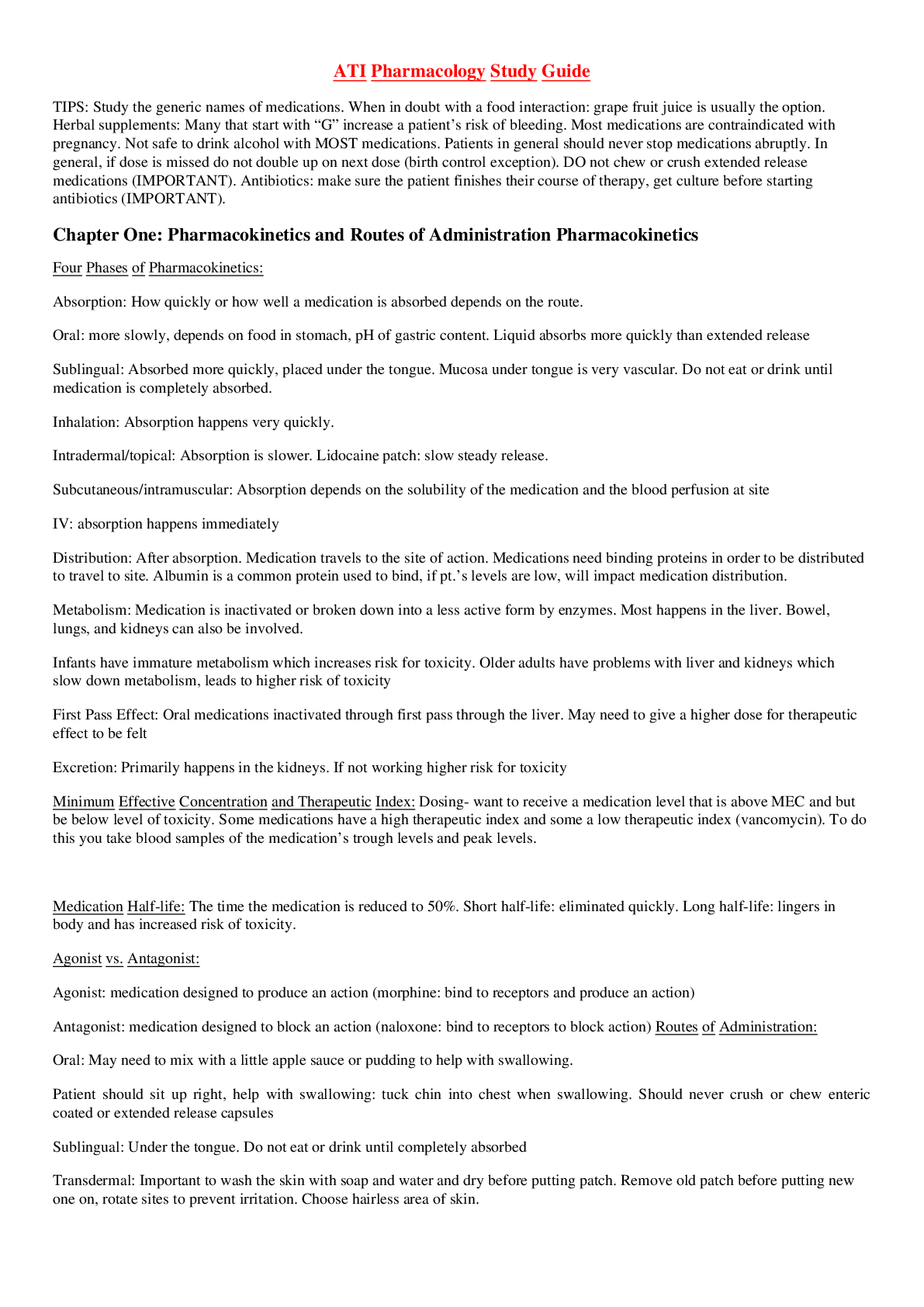
Buy this document to get the full access instantly
Instant Download Access after purchase
Buy NowInstant download
We Accept:

Reviews( 0 )
$6.00
Can't find what you want? Try our AI powered Search
Document information
Connected school, study & course
About the document
Uploaded On
Apr 04, 2023
Number of pages
18
Written in
Additional information
This document has been written for:
Uploaded
Apr 04, 2023
Downloads
0
Views
91


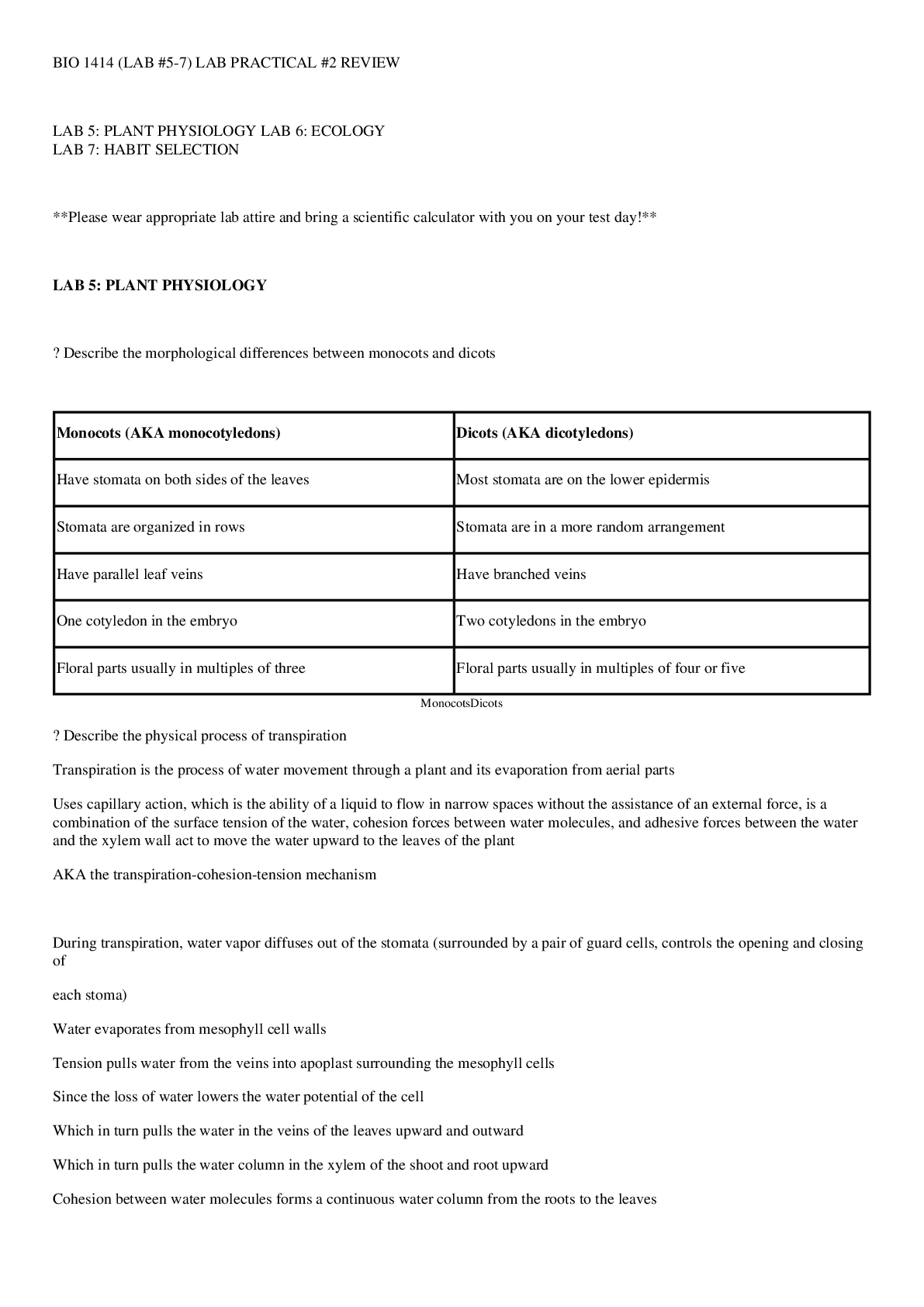
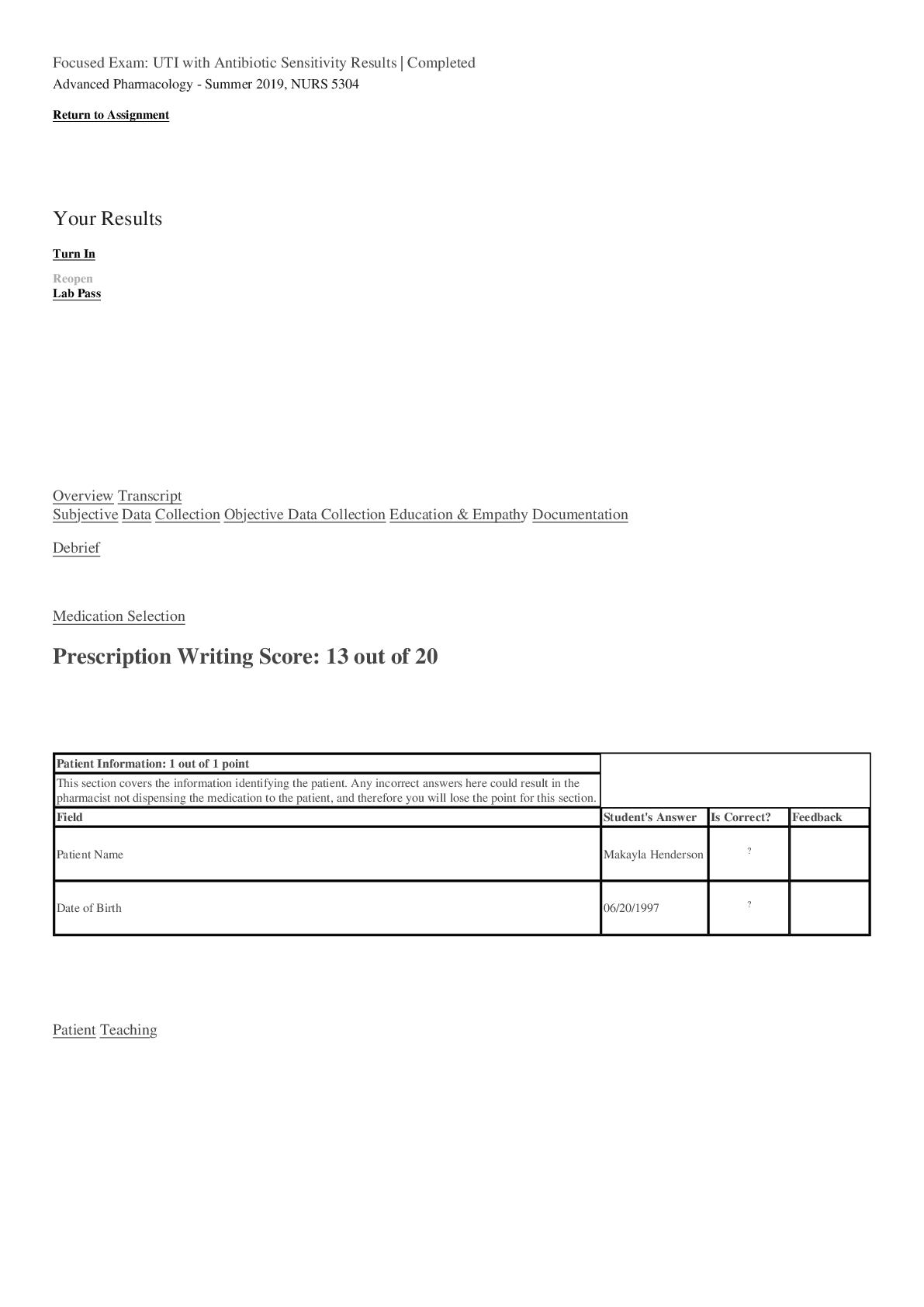

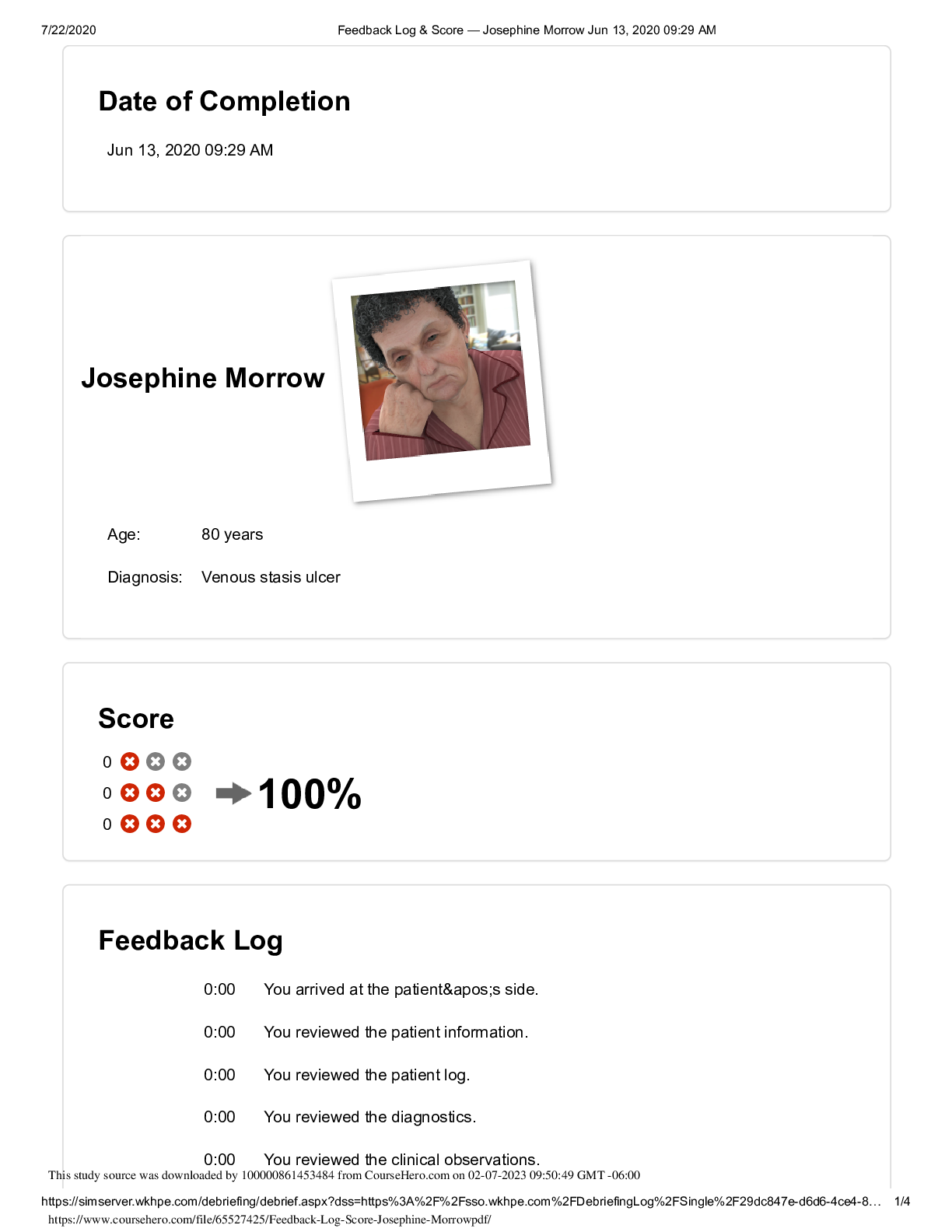
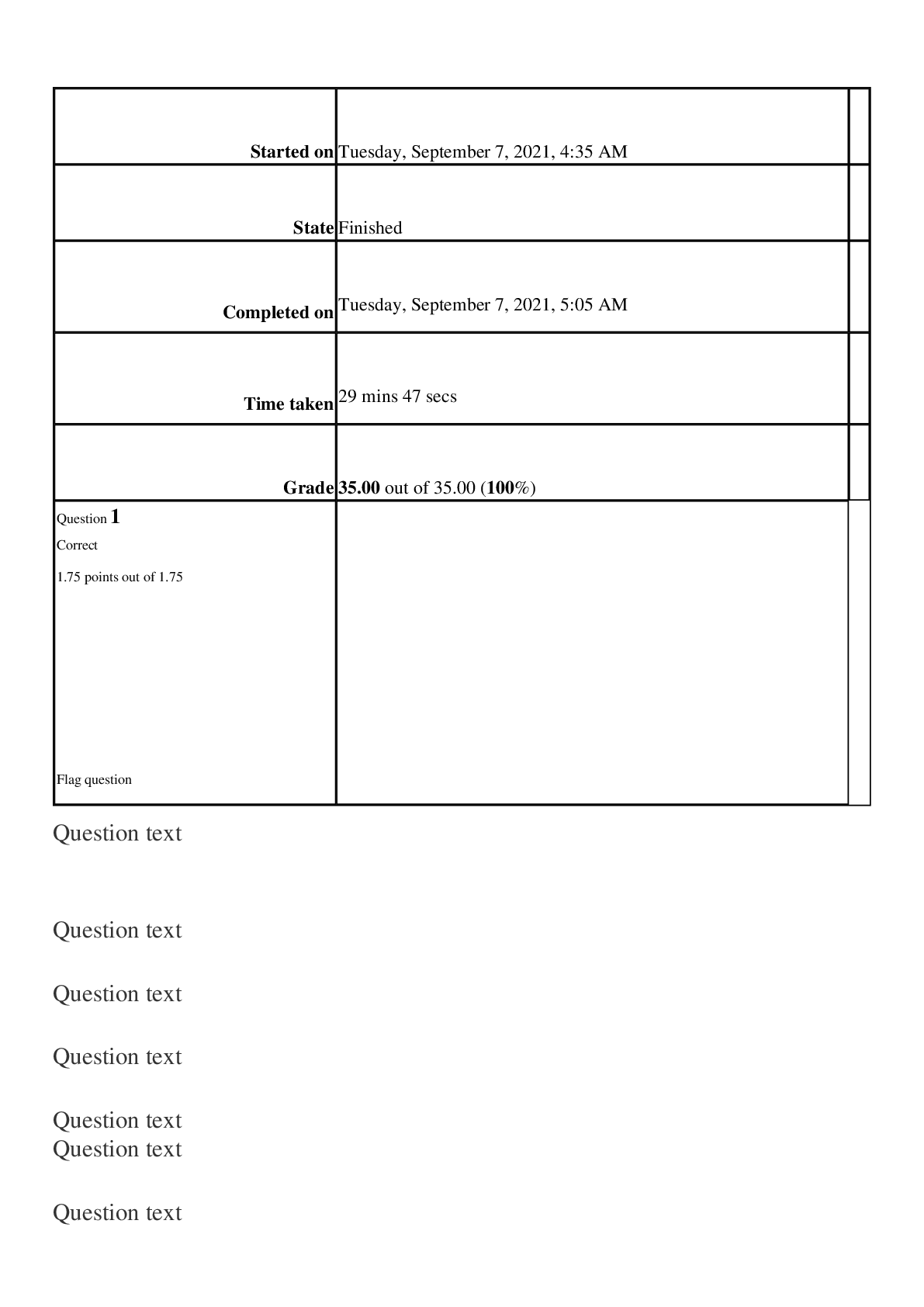

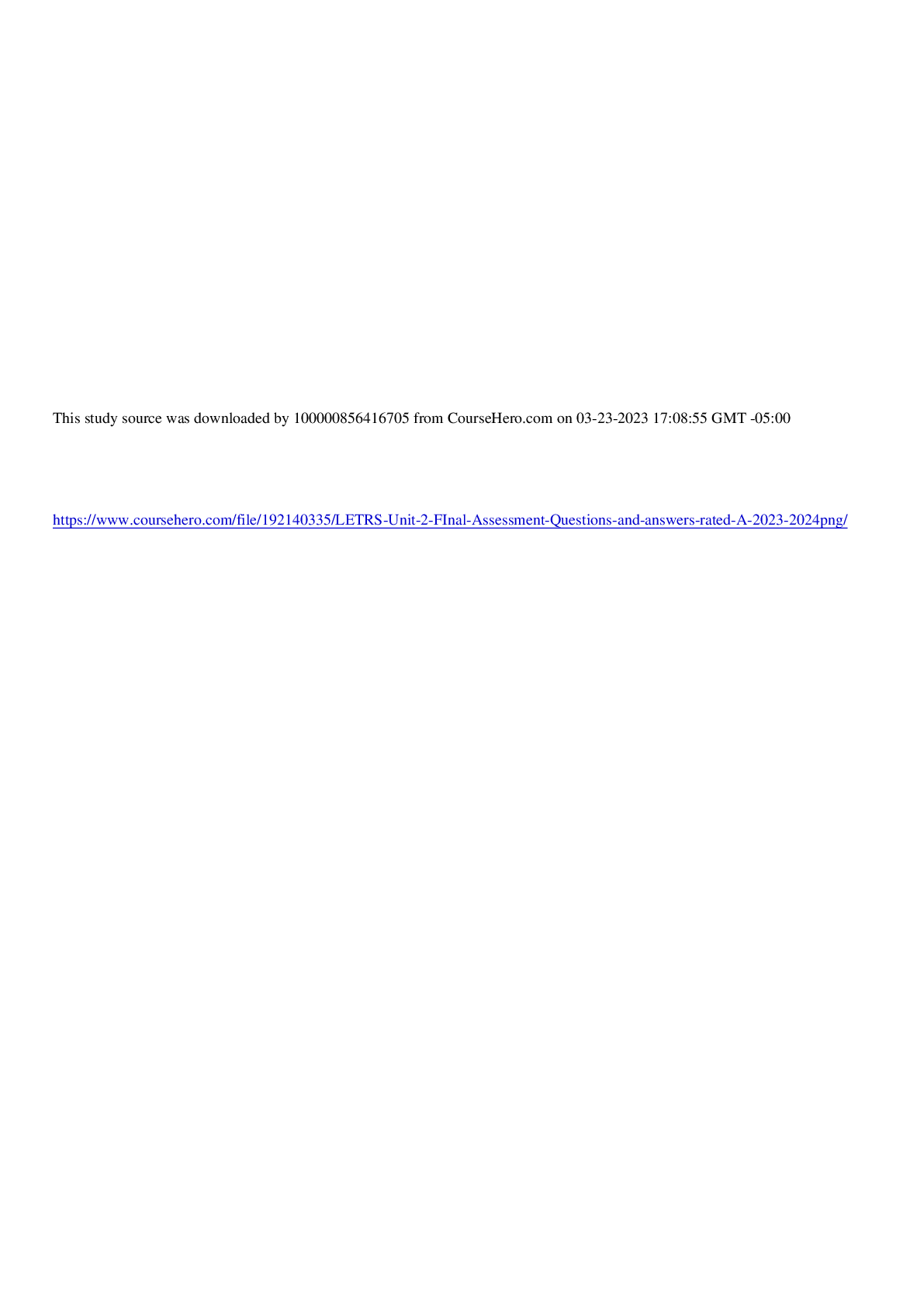
.png)

.png)


